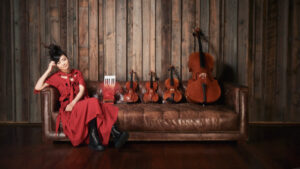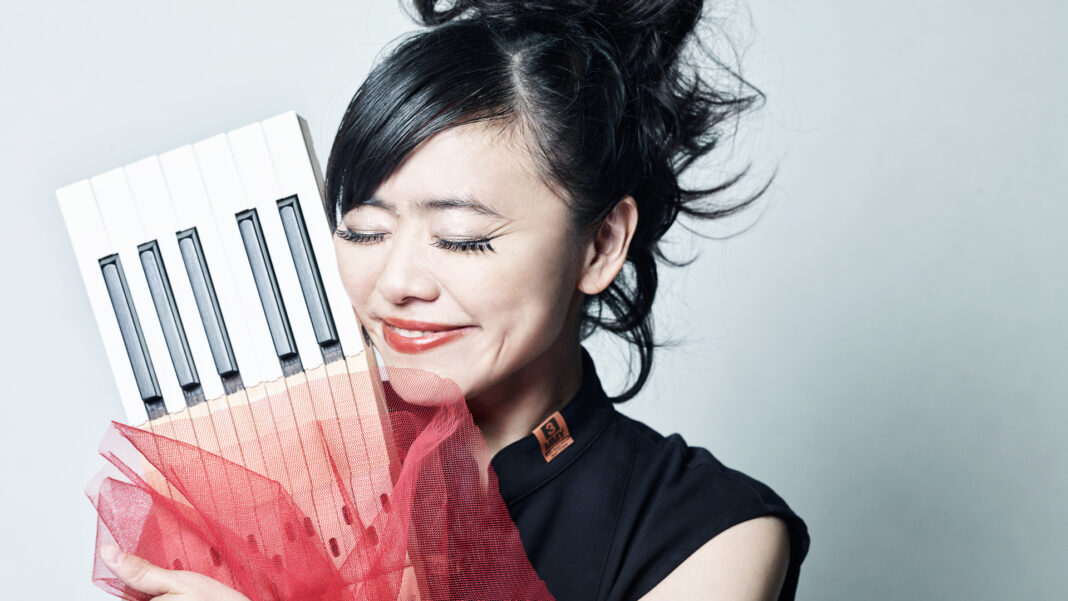
If you’ve ever listened to the recordings of jazz pianist Hiromi, you can certainly detect a classical music background in her playing and in her sensibilities. It should probably come as no surprise that for her new album, Silver Lining Suite (coming out Friday), she has more than dipped her toes into the classical realm. Hiromi wrote a four-movement suite and performs with a string quartet.
She will be performing Silver Lining Suite at New York’s Sony Hall on Thursday and Friday. If you’re expecting her more traditional jazz stylings, you’re going to be surprised. Hiromi composed the work over six months last year. With tracks like Isolation and The Unknown, it is clear the pandemic inspired her.
Hiromi starting making a name for herself on the international stage in the early 2000s. Nate Chinen of the New York Times said of a concert she gave at the Highline Ballroom in 2010, “During the second of two 90-minute shows, she radiated more than enough energy for the room…Her playing itself was athletic, in an Olympic sense: brutally efficient, singularly focused, imperious in its physicality.”
Earlier this week I spoke via Zoom with Hiromi about writing Silver Lining Suite during the pandemic, her passion for George Gershwin and what she learned from collaborating with classical musicians. She is a woman of few words, but they are all chosen carefully. What follows are excerpts from our conversation that have been edited for length and clarity.
Hiromi, was the pandemic a blessing or a curse in terms of your creativity?
I always loved writing, but I just felt like I needed to write to feel alive. So that’s very different. I lost the chance to perform and I basically kind of lost the space to release my energy. So writing music was the only place I could feel creative. So I really needed the space.
When you were younger and learning piano you did improvisations on works by Mozart and Haydn. How much of that early training influences your writing style for this project?
I don’t know. Even though it’s such a classical format that I wrote this music for and I’m influenced by classical music, I wasn’t really thinking much about writing in a classical format. I grew up listening to it and I grew up playing the classical music, so I’m sure I’m inspired and I’m influenced by it, but I don’t know. The influence is hard to say.
Composers like Gershwin, Stravinsky and Ravel were among those who were able to marry classical and jazz in ways that I think set the standard. What are the challenges in continuing in that tradition and still finding new ways of expressing that combination of genres?

I never really grew up listening to music by genres. My first classical piano teacher happened to be big jazz fan, so she just introduced me to classical music and jazz music equally. She would introduce me as this is Erroll Garner. This is Martha Argerich. I wasn’t really thinking, OK, now I’m going to listen to jazz. I was always like I’m going to listen to Errol. I’m going to listen to Bill Evans, you know? I don’t really go like combining those two like that.
How much does Gershwin and what he did inspire you? Because I think I hear a little bit of a Gershwin passage at about the two minute mark in The Unknown.
Gershwin, I’m sure it’s deep. It’s deeply in me because I grew up listening and I grew up playing his music, and I really just enjoy his work so much. His music’s fun, you know, so accessible and it’s like it’s hard to meet somebody who doesn’t like Gershwin. I always feel like rhythm and a swing in his music, which the other classical music doesn’t have. And I hear a lot of like stride piano is in it. I really love his music and the harmony too. It’s really beautiful when it’s played by orchestra and even his solo pieces, I really enjoy. I love his piano rolls that he recorded.
What inspires you most about playing with the four musicians who serve as your string quartet for Silver Lining Suite?
I just love the sound of strings. Pianos tones fade. The second you touch piano [it] just starts fading, and that’s the beauty of a piano sound. But the string instrument enhances the second they start playing. So it’s a bit like voice, and I think it’s probably the closest instrument to voice. So when I write the melody – just imagining that the melody is played by a string instrument – I write differently from when I write for piano. Just imagining that it’s almost like a song by a vocalist, that’s how I write a melody for strings and it was completely different approach. When I heard it for the first time, just the melodies played by them, I was really just so happy. It’s something that I kind of dreamed of when I was writing and just hearing it right in front of me was just amazing.
What has performing this music given you that is unique to what you’re able to bring to a performance stage when you play solo piano or in a jazz trio?
It’s not a drastic change from playing with a trio. I learned that playing with classical musicians is they’re so precise. For example, if I’m playing one melody. And let’s say the take before I was playing the melody really short, staccato, and this time I was playing like you kind of little longer, like what’s called marcato. The violin player [asks] so which part do you want me to play? You want shorter or longer? They really read the music. They get all the information from sheet music. So staccato means like how long? And I’m like, OK, I didn’t know I had to be that detailed because I was just playing things; sometimes I felt like playing longer and sometimes I felt like playing shorter. So I was little more loose in that sense, right? But they are so precise and I learned that when I’m playing, especially the ensemble parts, it’s better that to be precise in this format so we can really sound strong as an ensemble. I learned a lot about classical music playing with them.
Maybe you’re inspiring them to start taking up some jazz.
I actually did encourage them to play an improvisational couple of bars actually in the the last song of the album and they did play improvisation. And the more we played together, the improvisational quality gets longer. In the beginning four bars is enough or eight is enough. Now they’re playing like three choruses. So it’s interesting to see because they have great ears and they’re first class musicians. And once they get it, it’s so quick.
The late Chick Corea, who was a mentor to you and a collaborator, said, “I’ve noticed that the more adventurous and in that mode that I am, it seems that the more the audience really likes it.” Your work throughout your career has been adventurous and as you have said many times, it doesn’t fit into any one mold. How much does being adventurous reflect who you are as an artist and who you are as a person? And how do you see your audience growing with that adventure?
I like being adventurous and always the bigger adventure brings something bigger. I think the important thing is you are having fun with adventure because you have to always find something that excites you as a musician. I have to find something which thrills me, inspires me and excites me. That actually becomes so much fun to do, to explore. So I think the single most important thing is that the musician is having fun and exploring new musical journeys. That’s when the audience feels the same amount of fun the musician is having.
All photos of Hiromi by Mari Amita/Courtesy Concord Records
Update: We meant to say Hiromi made a name for herself “on the international stage” in the early 2000s. Her career began in Japan in 1993. We have updated our post to include that added phrase and apologize for the error.













Super, thanks. If we’re talking worlwide, then this: “Hiromi starting making a name for herself in the early 2000s” should be 1993, when her first album was released. In Japan, Hiromi started making a name for herself long before that.
Thank you for your comment. I should have had “on the international stage” – which has now been added to the story. Thanks again.